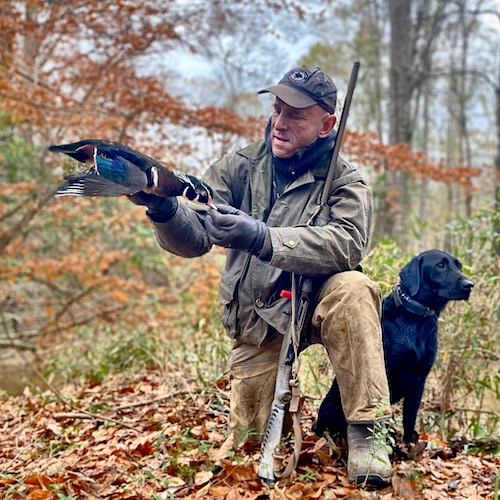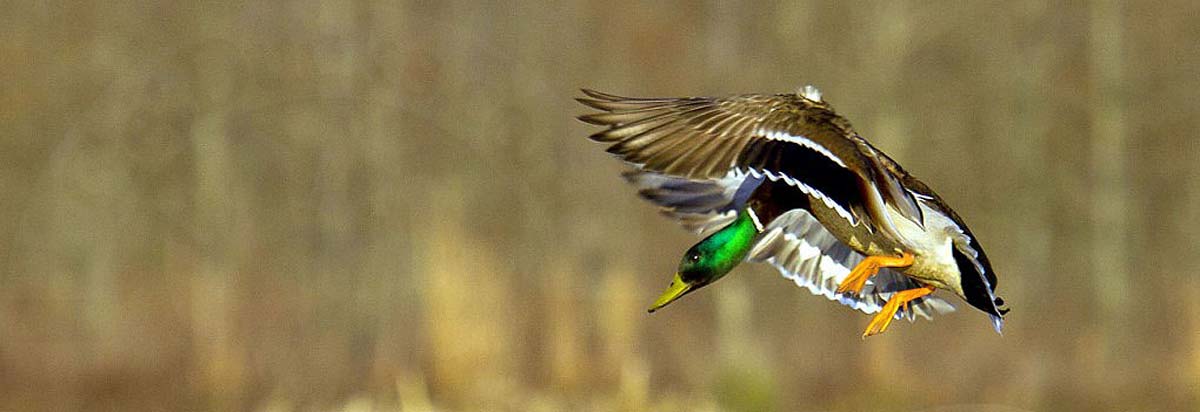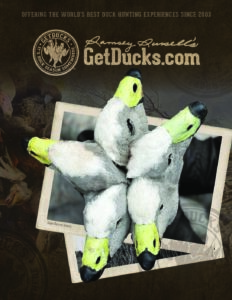Wood Duck

Wood Ducks (Aix sponsa) are among the most spectacularly adorned and recognizable North American waterfowl species. Drakes and hens of this species are dimorphic, and each is distinct. Drakes are unmistakable with their large, long crests of iridescent green, red eyes, multi-colored bills, and white throats with prongs extending upwards; a deep chestnut, white-speckled chest and a tan, rectangular underbelly patch. Hens are mostly sooty gray-brown and white underbelly with prominent, white, “teardrop” shaped plumage encircling the eyes. During flight both sexes display flashy blue secondaries and will bob their heads up and down, a behavior that is specific only to this species. The square-shaped tail is a tale-tell sign of woodies in flight. Vocalizations include the hen’s ooo-ee and drake’s high, rising jeeee, which have lead to wood ducks being colloquially referred to as squealers. The Aix genus is shared with only one other species, the equally flamboyant Mandarin Duck.
Available Hunts
-
Arkansas Duck Hunting
Arkansas duck hunting camp experience on one of the state's most coveted properties. Location, location, location - smack in the middle of a 6,000- acre federal sanctuary, the area literally swarms with ducks daily.
...read more- Exclusive property surrounded by federal sanctuary holds many ducks for the entire Arkansas duck hunting season.
- Predominately mallards, pintail, gadwalls, green-wings and more
- Spacious, covered blind holds up 8-10 guns is very easily accessed with short, dry walk. Leave the waders at home!
- Large, deluxe 4-suite lodging
- Excellent home-cooked meals provided
- Located 30 minutes from Bastrop, 1 hour from Monroe, LA
- Corporate group rates
Rate: $650 day -
New England Sea Duck Hunting
World renown for its eider hunting, New England waterfowling offers an incredible change of scenery and is an excellent place to check off lots of North America waterfowl species. Codfather Charters specializes in making your hunt priorities a reality.
...read more- Decade-plus experience for trophy eiders, other sea ducks, divers, dabblers, mergansers, geese
- Best place in US to harvest prime American black ducks
- Customized hunt plans reflect hunter priorities, not a “one size fits all” type 1/2-day hunt
- Includes hotel accommodations, full-day hunting, continental breakfasts, made-to-order lunches
- Recognized as foremost among US waterfowl collectors and taxidermists
- Nearby non-hunting spouse activities abound
Rate: $2,500 for 3-day inclusive package

Wood Ducks breed in the eastern half of Canada, the United States, and even into Cuba. They nest in tree cavities high above the ground to deter egg depredations and readily take to manmade nesting boxes. Artificial nest boxes placed by hunters have resurrected wood duck populations. The California Waterfowl Association nest box program has produced nearly one million since inception! Females have been known to take part in intraspecific brood parasitism in which hens visit cavities of other pairs and lay her eggs to have the other hen raise her young. During brood rearing, ducklings and hens will deviate from their normal herbivorous diet and consume terrestrial and aquatic invertebrates in greater amount.
Wintering grounds are found almost entirely within the United States, throughout all 4 US flyways, with the greatest abundance of individuals found in the southeastern states (i.e. Louisiana, Arkansas, Mississippi, Alabama, Georgia, Florida, and North and South Carolina). Wood ducks favor shrub-scrub habitat consisting of heavily vegetated wetlands because of their mostly vegetarian diet and desire for proper cover. They readily consume acorns, samaras, soybeans, blackberries, duckweed, and waterlilies.
Wood Ducks have an incredible conservation success story due to this species being almost extinct by 1900. Since then, especially over the past fifty years, Wood Duck populations have steadily increased. The name summer duck refers to their having been hunted late-spring through summer preceding the Migratory Bird Treaty Act. With the exception of the Pacific Flyway, where the daily bag limit is 7, wood duck bag limits throughout the United States is 3. This is generally because the habitat preference precludes accurate arial surveys. Biologist rely increasingly on leg band recovery data to estimate population, harvest, and age/sex trends. More Info: Mississippi Wood Ducks, Houston Havens, Duck Season Somewhere podcast.
WOOD DUCK. To a native Mississippian, woodies are pretty ordinary ducks because they’re year-long residents to the Deep South. Southern swamps, creeks and rivers also overwinter wood ducks that breed in the northern US, too, where they feed on acorns, aquatic vegetation and invertebrates. I’ve recovered wood duck bands in Mississippi from Tennessee, Minnesota and Wisconsin, but never originating in Mississippi; shot them up and down the Flyway from Manitoba to Louisiana, and from California to New Hampshire. In hand, they’re spectacularly colorful during hunting season. They’re a waterfowl conservation success story, too. They were believed to be nearly extinct pre-Migratory Bird Treaty Act, during the early part of the 20th century. That may likely have had as much to do with initial cuttings of the continent’s virgin bottomland hardwood forest as with hunting, but “summer ducks,” as they were called in some locales, were hunted during the breeding season then. It’s nearest relative is the Mandarin Duck, native to Asia, that look and behave similarly. They’re primarily cavity nesters, and are the only North American duck species capable of successfully raising 2 clutches per year. I can remember a wood duck nesting in a hollow sycamore behind a bagel shop in college town, Mississippi, the nearest water more than a mile distant. Funny story, the time a couple European guests visited Mississippi. Rivaling only a king eider was a wood duck for their collection back home, saying it’d be the only wild harvested wood ducks among the many collections in their homeland. As luck would have it, the first duck took 3 days to score. It was pulled from a flock of high-fliers, bouncing from every limb as it fell through an ancient oak, landing with a muddy thud. Sprinting to the spot, he reached down, picking up two items. Not a feather out of place but the head has been stripped from the body. Learned that morning that they use the same f-bombs we do over here! We got their trophy wood ducks during remaining hunts, but still talk about that first one when visiting.







